

 |
 |
 |
Guest - Not logged in | ||||||||||||||||||||||||||||||||||||||||||||||
Reviews > Packs > Frameless Backpacks and Day Packs > Osprey Talon 33 Pack > Test Report by Jo Ann MoffiOSPREY TALON 33 PACK
INITIAL REPORT: November 30, 2007 FIELD REPORT: February 23 , 2008 LONG TERM REPORT: April 20, 2008 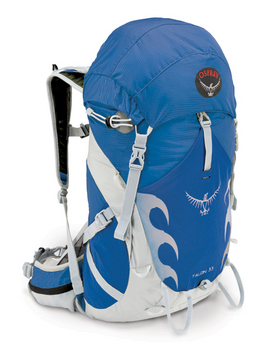 Photo Courtesy of Osprey Packs, Inc. Website
Product Information Manufacturer: Osprey Packs, Inc. Year of Manufacture: 2007 Made In: Vietnam URL: http://www.ospreypacks.com/ MSRP: N/A Size: M/L 33 L (2000 cu. in.) Also available in S/M 31 L (1900 cu. in.). Colour: Moonlight Blue Also available in Spicy Chili (orange) and Acid Green (lime green). Carrying Capacity: 9-13.6 kg (20-30 lbs) Listed Weight: Size M/L: 0.85 kg (1 lb, 14 oz) Actual Weight: Size M/L: 0.85 kg (1 lb, 14 oz) Materials: Top Pocket: 70D x 100D Nylon Shadow Check Front & Side Pockets: Stretch Woven Nylon with Lycra Body of Pack: 160D x 330D Nylon Shadow Box Warranty: From the Osprey Pack, Inc. hang tag on the Talon 33 pack: "Osprey covers defects in materials and craftsmanship for the reasonable lifetime and intended usage of your pack. Should any flaw appear due to defective materials or craftsmanship, we will happily repair or replace the product at no cost to the owner." INITIAL REPORT Date: November 30, 2007 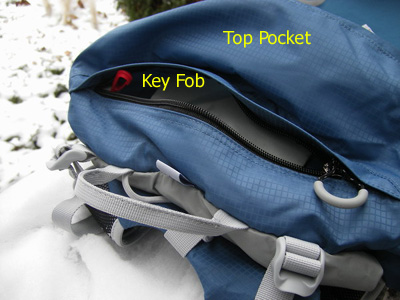 Item Received: November 26, 2007 I received the Osprey Talon 33 Pack in excellent condition. The pack appears to be what is advertised on the Osprey Packs, Inc. website and more. I must say I am very impressed thus far with this pack and I haven't even gone anywhere with it! The Osprey Talon Series Owner's Manual outlines the following features for the Talon 33:
The AirScape Backpanel is a foam Backpanel with integrated air channels covered with a mesh material. There is a channel that runs down the center of the backpanel in the area of the spine and branches at about the level of the bottom of the ribs and goes across to the outside of the pack. The material on either side of the channel and across the bottom of the backpanel is made from 4mm HDPE foam and is also ridged with small channels. Torso Adjustable Harness The shoulder harness can be moved up or down the pack via a 'rip and stick' panel of hook and loop tape sewn into the back panel of the pack. There are three arrows on the back of the shoulder harness panel that are lined up with another arrow located on the backpanel of the pack to make it easy to center the shoulder harness panel on the pack when you are moving it around on the rip and stick panel. These arrows look like the wings of a bird in flight. There are also two straps on the top of the shoulder harness for fine tuning pack fitting and the usual straps at the bottom of the shoulder harness for tightening down. 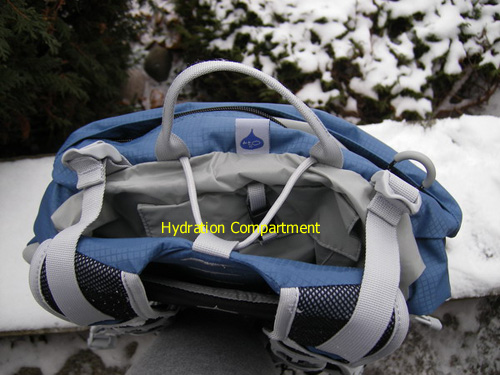 Hydration Compartment The hydration compartment is located between the backpanel and the main pocket of the pack. To access the compartment, I simply have to unclip the snap closure on the top and slide my hydration sleeve into the compartment. My hydration sleeve will hang from a small hoop of webbing that opens and closes with a small plastic clip. On the back of the hydration sleeve there is another bonus pocket similar to the internal stash pocket in the top pocket of the pack. Initial Fitting: The first fitting required me to move up the torso adjustable harness to allow the pack to sit further down my back to make the hip belt fit over my hips rather than around my waist. I loaded the pack with several small items to get a feel for having weight in the pack. The pack is very comfortable. The pack's first outing will be a cross-country skiing day this coming weekend. I plan on using the pack while hiking, backpacking, mountain biking, canoeing, running, cross country skiing, snowshoeing, snowboarding and for any other activity that comes my way that I feel pack would be functional for. I will be checking on the fit, comfort, the functionality of the features this pack has, the pack's durability, the field performance, and how easy it is to care for. FIELD REPORT February 23, 2008 Testing Locations: I have used the pack for outings hiking, cross country skiing, snowshoeing, and snowboarding. The hiking, skiing, and snowshoeing have been primarily in the Hiawatha Highlands and Voyageur Trail system areas in the Algoma region. These two areas have many linked trails meandering through red and white pine old-growth forests and dense boreal stands of jack pine and spruce linked by a network of rivers, lakes, and wetlands. I also took the pack with me on an afternoon snowshoe trek Goose Creek State Forest, Frederic Michigan. It is part of Michigan's Shore-to-Shore Riding/Hiking Trail. The area I snowshoed in was a relatively flat section of trail that meanders through pine and spruce forest with fairly open areas under the trees. Snowboarding this year has been exclusively at Searchmont Ski Resort in Searchmont, Ontario. 'Searchmont' as the locals call it is an 18 run mountain with an elevation of 488 m (1600 ft) about 45 minutes north of Sault Ste. Marie, Ontario. The section of the Appalachian Trail we hiked meanders along ridges with an elevation range from 762-1372 m (2500-4500 ft) through the Chattahoochee National Forest. Most of the leaves were off of the trees and the trail was leaf covered, thicker in some areas and slippery when damp. There were muddy sections and several creek and river crossings as well as some beautiful areas of fast moving water and waterfalls. The forest is mostly hardwood. The creeks and rivers have dense rhododendron bushes lining their banks. The trail we travelled on was well marked and relatively clear of downed trees, branches and other such obstacles. Testing Conditions: Weather conditions in and around Sault Ste Marie, Ontario that I have been out with the pack in have ranged from 5 to -20 C (41 to -4 F). We have had the whole gamut of winter weather conditions from cold, clear days to full on snowfall. We have also had a few milder days thrown in as well. Although we have had much colder temperatures (-30 c (-22 F)), I generally limit my outdoor time when it is that cold out. Temperatures around -15 C (5 F) are about my limit. In Georgia over the holidays, the temperatures ranged from 19 t0 9 C (66 to 48 F) during the day, with wind speeds around 13 mph (20 km/h). The skies ranged from brief periods of sunshine and light cloud cover to overcast, and rain. General Use: I have used the pack back and forth to work, shopping outings, and as a general carry all for my 'stuff' on a daily basis since I received the pack. It has housed my wallet, sunglasses, gloves, a water bottle, keys, a novel, and other small miscellaneous items every day. I have also used it to carry gym clothes and other items. I find the side stretch woven pockets very useful for my sunglasses and gloves on one side and a water bottle on the other. I use the hip belt pockets for my keys when they are not in my jacket pocket and my MP3 player when I'm not using it. The top pocket or 'lid' as I affectionately call it houses my wallet, lip balm, knife, a snack or two, and papers etc. The main pocket I use for a novel, any clothing items I am carrying, and sometimes my lunch. 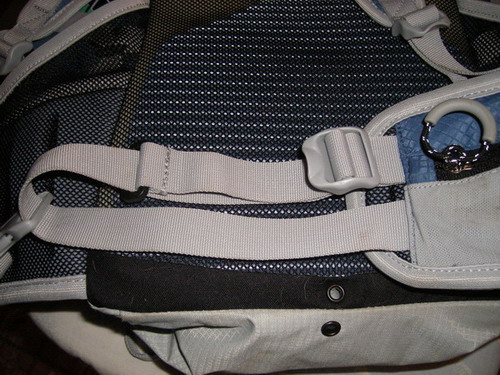 In preparation for my holiday trip to Georgia, I carried the pack walking back and forth to work for two weeks loaded with approximately 7 kg (15 lbs) the 3.5 km (2.2 mi) of miscellaneous books, clothing, and other items. This helped me to get the harness and other adjustments dialed in right with a bit of weight in the pack. I was pleased that this pack is easily adjusted. The torso adjustable harness is easy to move up and down via the 'rip and stick' hook and loop panels. I have the harness adjusted so that two of the arrows are visible. There is one more arrow's worth of adjustment available to make the distance between the top of the shoulder harness and the hip belt longer. One feature of this pack that I really enjoy is the extra little 'D' ring that is at the end of the straps for the shoulder harness and the hipbelt. It is a simple enough thing that keeps the extra long end of the strap from flapping around. It is difficult to explain, so I took a picture of it on the hipbelt, shown to the right. Hiking, Skiing, Snowshoeing, & Snowboarding As I have used the pack on a daily basis, when I used the pack on my weekend excursions skiing, snowshoeing, or hiking over the past 13 weeks, I generally packed the stuff I will be using on the outing into the main pocket. I do a bit of shuffling with some stuff like putting my keys and any other smaller items I don't want to lose while on the trail or the hill into either the 'lid' or one of the other two zippered pockets on the hip belt. Depending on the load I am carrying and what speed I am moving at, I may or may not use the hipbelt. If I am out for a short hike or snowshoe and I'm not carrying a lot of items in the pack, I have often found myself several minutes into my trek and feel the hipbelt straps hitting my legs. Often I will just attach them together to get them out of the way and continue on with the pack resting entirely on my shoulders. If I am carrying a heavier load or I notice the pack is moving a lot on my back, I will use the hipbelt. Most of the time, I barely notice the pack is on my back. It moves very well with me through all my activities. When I am doing a fast paced hike, I just strap on the hipbelt and I can even run with very little side to side movement from the pack. If I have loosely packed items or I have say a water bottle in the main pocket without much else in there with it, I do notice it bouncing up and down in the pack. I have found that a better place to stash a water bottle when moving quickly is in a side stretch pocket with the side compression strap pulled tightly over the neck of the water bottle. It keeps the bottle nicely in place without me worrying it will bounce out. I also strap down the top pocket as tightly as I can to keep it from bouncing when I am moving quickly. Georgia Appalachian Trail Trip The pack's first major outing was a multi day trip from Springer Mountain to Unicoi Gap at the bottom of the Appalachian Trail. I really wanted to see if I was able to carry what I needed for 3-4 days of backpacking without feeling deprived of my usual luxuries. Unfortunately, due to an injury on the trail, this trip was cut short. However, I did carry 3-4 days worth of stuff for 2 days of hiking. 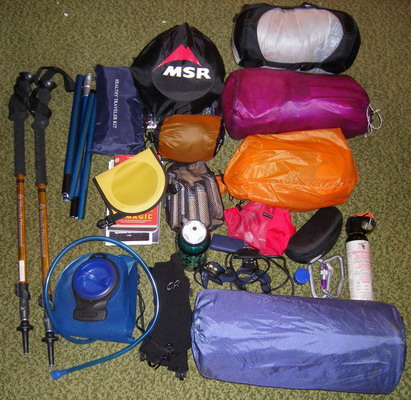
Total pack weight: 28 lbs, with 4 days of food and without water. 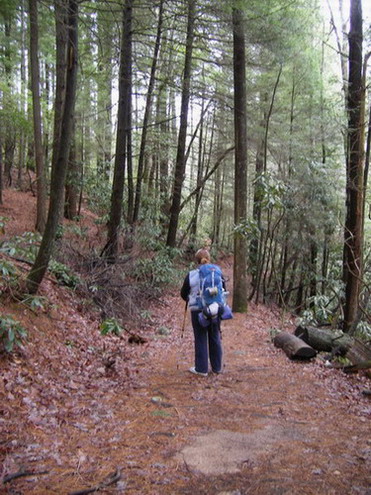 My
husband was stunned as to what I was able to fit into this pack. I am
normally a backpacker that likes creature comforts, but I'm not willing
to carry a ton of weight just so that I can have them in case I 'might' need them. Multi functional
is what I look for when choosing items I need. Suffice to say that I did
not feel deprived in what I took with me on this trip. I was able to
get everything I wanted to take with me into or attached to the pack.
My husband used a 72 L (4400 cu in) pack for this trip. We divided the items that we only needed to
carry one of between the two of us; the stove, the cooking gear,
and the tent. I ended up with more of those items and he had the larger pack! My
husband was stunned as to what I was able to fit into this pack. I am
normally a backpacker that likes creature comforts, but I'm not willing
to carry a ton of weight just so that I can have them in case I 'might' need them. Multi functional
is what I look for when choosing items I need. Suffice to say that I did
not feel deprived in what I took with me on this trip. I was able to
get everything I wanted to take with me into or attached to the pack.
My husband used a 72 L (4400 cu in) pack for this trip. We divided the items that we only needed to
carry one of between the two of us; the stove, the cooking gear,
and the tent. I ended up with more of those items and he had the larger pack! The pack carries very well loaded with 3-4 days worth of gear. I was not particularly careful of how I loaded the pack. My sleeping pad and food were closest to the bottom, which were my two heaviest items aside from my hydration bladder when full. The hipbelt is very comfortable and held the load well. I did not have any pressure areas on my hips or shoulders after two days of hiking. I was concerned before embarking on this trip that the hipbelt would be inadequate for such a load, but I needn't have worried. After this trip with the Osprey, I will find it difficult to justify carrying a larger pack for multi day trips. I liked how much more free my body felt on the trail. I felt very balanced and hiked along easily in areas where I would have felt a larger or heavier pack. Durability: While on the Appalachian Trail, I pulled down on the compression strap for the main pocket and popped off the slide lock portion of the buckle. Oops. I'm not sure if it was just my desire to get the compression strap as tight as possible or some sort of a defect in the buckle that made it break, but break it did. The buckle still functions to hold itself together, but the strap can no longer compress the load. I have the strap tied to itself right now, but I have contacted Osprey to get a replacement for the buckle. Stay tuned for the results of this contact in the Long Term Report. Otherwise, I am very pleased with the durability of the pack. The fabric of the main pocket and the stretch pockets were stretched to their limits with the gear I had in the pack for the trip to Georgia. The various tie off points have all been used on multiple occasions for anything from my sleeping pad to hiking poles and the dog's leash. The pack has been placed on dirt, rocks, leaves, snow, ice, logs, the bumper of my car, slid around in the back of the car, and on the floor of the bus. It is showing a bit of dirt, but most can be easily brushed of with my hand. I have had a fruit drink leak in the stretch side pocket, but a small stain is only evident on the lighter grey coloured top edge of the pocket. For the duration of the test period, I have one more backpacking trip planned as well as my usual snowshoeing, skiing, and hiking activities. As the weather gets warmer, it will be interesting to see if the AirScape Backpanel gets a chance to show its functionality as well. LONG TERM REPORT 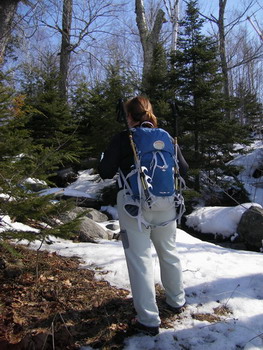 April 20, 2008 Testing Locations: I have continued to use the pack on all my outings this winter. I hiked an average of 5 km (3 mi) per week (usually on snowshoes) over the Long Term Reporting period. Sometimes this would be a 2 km (1.2 mi) trek, others times it would be a 7 km (4.4 mi) trek. There were additional days where I have gone longer distances. The long term testing has seen me snowshoeing as well as hiking on packed trails in the Hiawatha Highlands area described in my Field Report, as well as some frozen lake hiking later in the season on Lake Superior in Northern Ontario. Testing Conditions: The weather has been ideal this winter; we've had heavy snowfall during the week with the weekends sunny and clear. The temperatures ranged from -10 to 23 C (14 to 73 F) during the Long Term Reporting period. Performance in the Field: Since the Field Report, I have used the Osprey Talon 33 exclusively as a day pack. It carried extra gloves, a hat, mitts, an extra base layer shirt, maps, trail guide, and sometimes my gaiters in the main pocket; snacks, wallet, keys, sunglasses case, camera, pocket knife and first aid stuff in the top pocket; and a water bottle or two in each of the two side pockets. The front stretch woven pocket I used for my dogs' leashes and their boots. Although I have used the hydration pocket, I much prefer to have my water in a bottle or two in the side pockets. The shape of the hydration bladder against my back is not very comfortable. This is most likely due to the design of the bladder itself, not the pocket on the pack. In using the side pockets this way, I have found that they are a bit difficult to reach when the pack is on my back. It is not impossible, but if my husband was hiking with me, I would frequently ask him to pass me my bottle rather than contort my hand to get at the bottle myself. After a hike when I looked at the pack when it was not on my back, I noticed that when I would put the bottle back into the pack while it was on my back, it wouldn't get quite down into the bottom of the pocket. The side compression straps cross over the side pocket and the bottom of the strap would sometimes prevent the bottle from getting down into the pocket all the way. I was using 500 ml (17 oz) aluminum bottles. I didn't try these pockets out with a 1 L (34 oz) bottle. I spent a four day weekend at our family camp on Lake Superior in early April. We hiked each day up the lake. It was unseasonably warm and the ice had a layer of slush and water on it about 10 cm (4 in) thick. I thought I would need my hiking poles, but we were able to follow a packed snowmobile trail that ran about 200 m (656 ft) from the shore, so the poles were unnecessary. I used this opportunity to try out the pole straps on the pack. They work great; the poles are well secured and don't flop around when I'm hiking. As this past week has been warm enough that all the snow has melted on the roads and in most of the park area in town, I took my bike out for a tour and tried out the pack with the bike. I found a very interesting fitting issue. When hiking, I have the torso adjustable harness arrows moved out to its furthest point. When I was just heading out from my street, I could feel the top of the adjustable harness digging into the back of my neck. I stopped and moved the harness to its smallest point, thus making the pack shorter in the back and lengthened out the shoulder straps so that it rode lower on my back. This solved the issue and I was able to enjoy the rest of my ride. The only time I wore the pack during warmer temperatures was in the last few days of the test period. For the most part, the AirScape back panel did a great job of keeping my back cool. It was only during my first strenuous bike ride of the season that I noticed that my back was getting warm and sweaty. The temperature was around 23 C (73 F). Contacting Customer Service: I emailed Osprey about the broken buckle that I mentioned in the Field Report. They were very quick to reply on the same day with the offer of a free replacement for the buckle. After confirming with me which one I was referring to, Megan from the Returns Department mailed one to me. The replacement arrived about a week after my original email. Very nice customer service! Durability: I have had no further issues with any of the buckles on the pack. All the stitching has held up very well, even after being stuffed to its max on several occasions. Loose dirt and debris easily brushes off of the pack. I haven't had any of my gear poke through the fabric, nor has any of the branches and trees I have walked by and scrambled through snagged the fabric. There are a few dirtier areas of the pack from putting it down on the ground or downed trees, but nothing more than I would expect from normal use of the pack. 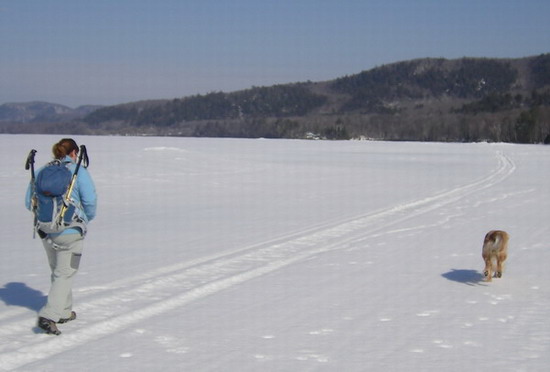 Likes: The roominess for a day pack The front stretch pocket - an easy stash for items I need quickly The hip belt cinching strap Dislikes: The side compression strap location - it could be higher away from the side pockets Overall this is a great pack. It makes a fantastic overnighter pack and is roomy enough that I can carry enough stuff for myself and my husband on most of our day trips. It will continue to be the pack I reach for on my short overnight trips and for my day hikes. This concludes this test series. Thank you to BackpackGearTest and Osprey Packs, Inc. for the opportunity to test the Osprey Talon 33 Pack. Read more reviews of Osprey gear Read more gear reviews by Jo Ann Moffi Reviews > Packs > Frameless Backpacks and Day Packs > Osprey Talon 33 Pack > Test Report by Jo Ann Moffi | |||||||||||||||||||||||||||||||||||||||||||||||